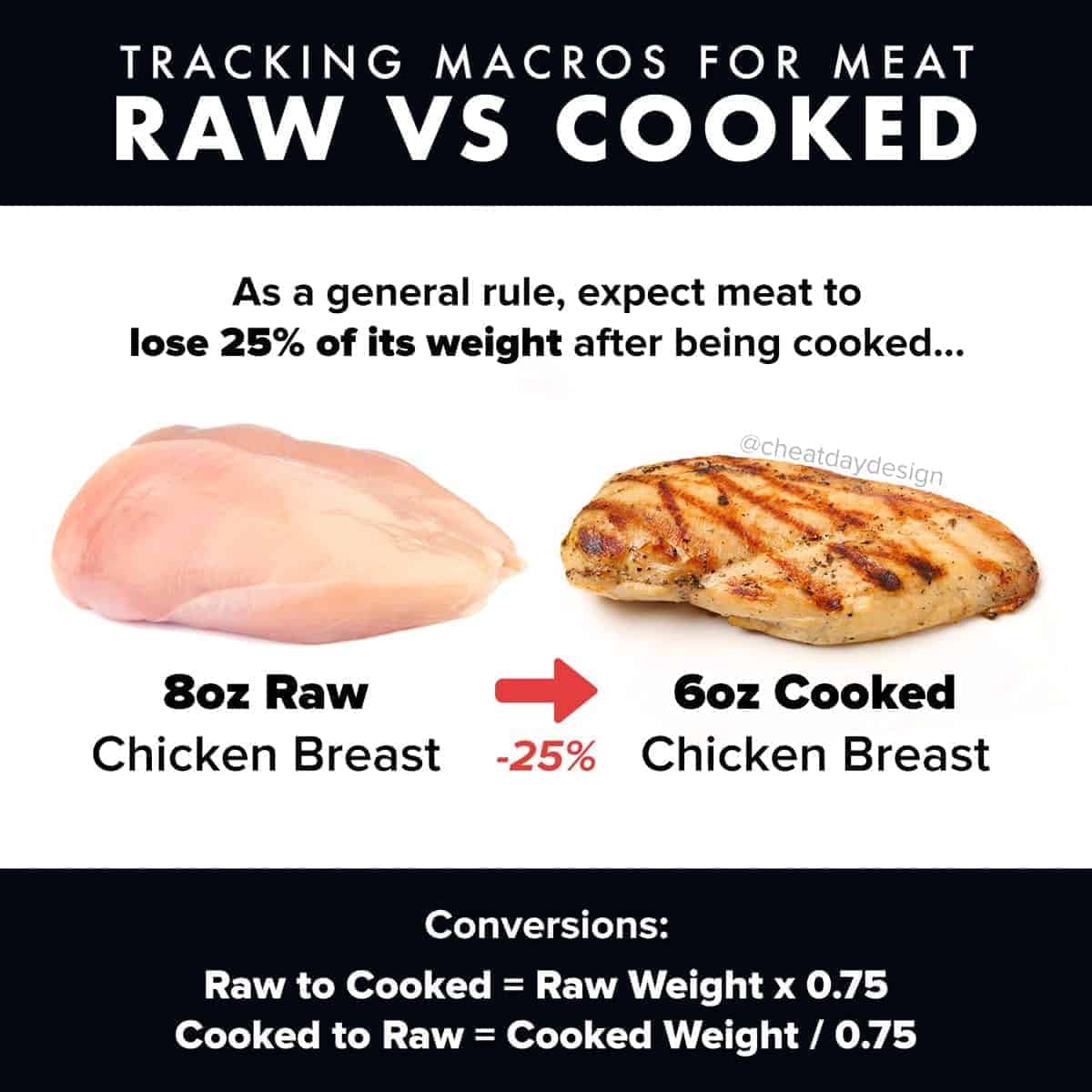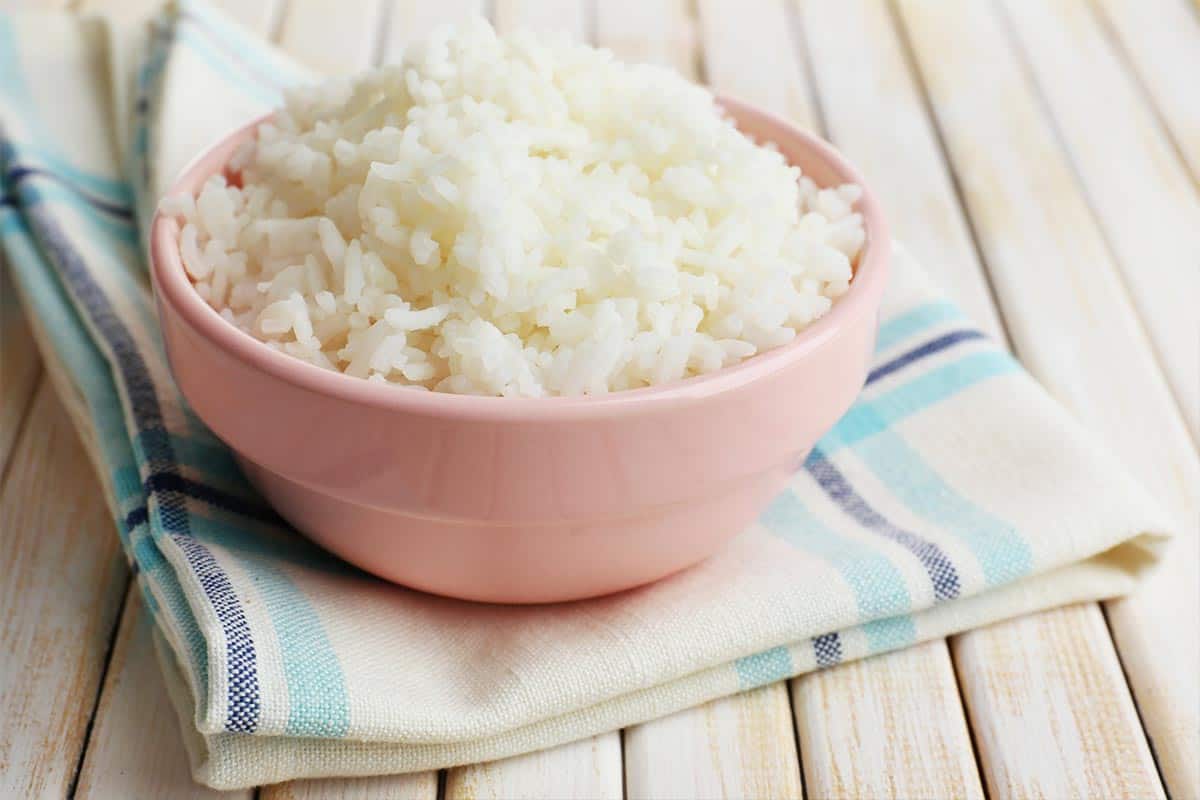Tracking Macros of Raw vs Cooked Meat (and other foods)
A very common question people have in regards to tracking their food is: “do I weigh my food raw or cooked?”
Truthfully, you can do either, as long as you’re consistent with it.
I always recommend weighing raw ingredients whenever possible, because it is always going to be the most accurate. When you cook food, there are various cooking methods, sauces, ingredients, etc, that can all affect the final cooked weight.
When you stick with the raw weight, you eliminate all of those variables.
That’s not to say that weighing your cooked food is inefficient, but let’s explore why weighing food raw is most effective…
Nutrition labels always display information based on raw weight

The nutrition facts of your food will always be based on raw weight, unless otherwise specified.
Most packages of bacon will say “2 pan-fried strips” as a serving, which refers to cooked bacon. Otherwise, if it doesn’t specify, it implies that the food is raw.
Let’s look at ground beef as an example.
A single serving of 4 ounces of ground beef is based on 4 ounces raw ground beef.
When you cook that ground beef, those 4 ounces will cook down to about 3 ounces.
If you were to track the 3 ounces of cooked meat, you would track it as 4 ounces of raw meat as seen on the nutrition label.
How can 3 ounces of cooked meat have the same nutrition as 4 ounces of uncooked meat?
The only thing changing here is water weight. When the meat cooks, it loses water. Nothing else is changing!
This is where people get confused, so I want to say it once more.
Even though meat weighs less, the nutrition is still exactly the same.
Do calories or macros change when you cook food?
Whether you’re weighing your food raw or cooked, the calories aren’t changing.
This throws a lot of people off. How can 2 ounces of raw rice have the same calories as 4 ounces of cooked rice?
Isn’t it double the amount?
Not exactly.
Sticking with the example of rice, when you cook it, all you’re doing is boiling it in water. The rice absorbs the water, leading to the serving doubling in size.
While the food weight has doubled, the volume is still the same. You have the same exact amount of rice!
If you have a 4 ounce serving of cooked rice, it has the same exact calories as 2 ounces of uncooked rice.
Raw to cooked conversions for various foods
![]()
If you’re reading this, you likely want to know how to do the conversion from raw to cooked weight, or vice versa.
Each food conversion is different, and there are quite a few variables to take into account so no conversion is going to be 100% accurate all the time. We’re going to dive into some actual conversions, but remember that there are some factors that can affect the weight:
- Different cooking methods will yield different weights. We’re going to look at standard cooking methods (like grilling chicken) but something like an air fryer may yield a slightly different weight due to the way it cooks.
- Sauces and condiments will affect your cooked food. If your meat has a marinade on it, the final cooked food may be slightly heavier than we’d normally expect, but it’s not enough to worry about.
- Each food has different types that may cook slightly differently. Pasta has a ton of different shapes that use different ingredients, there are tons of different cuts of meat, etc. The following conversions are estimates, but they’ll definitely be close enough for our purposes.
Raw vs cooked meat weight conversion

Raw to cooked meat conversion: Raw weight x 0.75 (example: 4oz raw x 0.75 = 3oz cooked)
Cooked to raw meat conversion: Cooked weight / 0.75 (example: 8oz cooked / 0.75 = 8oz raw)
While it will vary slightly depending on the type of meat you use, you can safely assume that cooked meat will lose about 25% of its weight once it’s cooked.
I’ve personally tested this a handful of times with chicken breast and can confirm that it is quite accurate. If you’re looking at cooked vs uncooked chicken, it will almost always cook down from 8 ounces of uncooked chicken to 6 ounces of cooked chicken.
If you are looking at the nutrition facts on a package of meat, it will be based on raw meat weight.
For ease, I recommend weighing the raw meat before cooking to take out all the guesswork. You will likely be adding spices, sauces, or marinades during the cooking process, which can affect the final weight.
But there are certainly cases where you’ll only be able to weigh your cooked meat, especially if somebody else is doing the cooking, and that’s where this conversion comes into play.
If you find yourself with an 8-ounce portion of cooked chicken, you can divide it by 0.75 to find that the nutrition will be equal to roughly 11-ounces of raw chicken. It may not be exact, but that will be a very close estimate.
Uncooked vs cooked pasta weight conversion

Raw to cooked pasta conversion: Raw weight x 2.25 (example: 2oz raw x 2.25 = 4.5oz cooked)
Cooked to raw pasta conversion: Cooked weight / 2.25 (example: 8oz cooked / 2.25 = roughly 3.5oz raw)
We’ve talked a lot about meat, which loses weight when it’s cooked due to a loss of water weight.
Pasta tells a different story. When you cook pasta, it actually GAINS weight.
When you look at the nutrition label of pasta, you’ll typically see a serving size of 2oz. That is 2 ounces of uncooked pasta.
If you were to portion out 2 ounces of cooked pasta for yourself, you’d be really disappointed to find out that the serving is TINY. Instead, you need to weigh out 4.5 ounces of the cooked pasta.
If you’re tracking your pasta, remember to weigh it before adding any kind of sauce.
Naturally, the sauce will add some extra weight which will throw off your conversion.
Uncooked vs cooked brown rice weight conversion

Raw to cooked brown rice conversion: Raw weight x 2 (example: 2oz raw x 2 = 4oz cooked)
Cooked to raw brown rice conversion: Cooked weight / 2 (example: 8oz cooked / 2 = roughly 4oz uncooked)
Similar to pasta, brown rice is going to increase in weight when cooked. Generally speaking, your rice is going to double in weight when cooked.
Rice is one of those foods that many people find themselves weighing once it is cooked. For example, if you get Chinese food takeout, you’ll find yourself with a pint of rice. So, how do you measure out a serving? That’s when these conversions come into play!
The serving size you choose is up to you, but whatever you choose to weigh out, remember that the uncooked weight is half of whatever you are weighing.
If you portion out 6 ounces of cooked brown rice and you are trying to track the nutrition, it will be the same nutrition as 3 ounces of uncooked brown rice.
Uncooked vs cooked white rice weight conversion

Raw to cooked white rice conversion: Raw weight x 3 (example: 2oz raw x 3 = 6oz cooked)
Cooked to raw white rice conversion: Cooked weight / 3 (example: 3oz cooked / 3 = 2oz uncooked)
White rice acts a little bit differently than brown rice, and it will generally triple in size when cooked.
White rice is always my go-to when I order takeout. If you find yourself with some cooked white rice and want to figure out the nutrition, you’ll need to divide the weight by 3.
If you portion out 6 ounces of cooked white rice, divide it by 3 to find that you are having the same nutrition as 2 ounces of uncooked white rice.
Should you track the raw or cooked weight of food?
If you’re tracking your macros (or just your calories) it can be tough to figure out how to accurately weigh your portions.
My recommendation, if you can help it, is to always weigh your food raw. It takes away any guesswork and confusion, and it’s consistent every time! Remember that the labels are always based on raw weight, so it makes your life the easiest.
Whether it’s meat, potatoes, pasta, or rice, it’s very helpful to weigh it out before you cook it. If you boil 4oz of rice, you know that you are making two 2oz servings- then you don’t even have to bother weighing it out at the end.
To me, that’s always the easiest way to go.
When it comes to meat, I always trim it down to the exact portion size I’d like. When it comes to chicken breast, I’ll trim the raw chicken to the 8oz portion I want. Then when it’s cooked, it doesn’t matter what the weight is! We know that it’ll cook down to 6 ounces, but then we can play with marinades, sauces, and spices without any worry.
That being said, I totally understand that sometimes you are not able to weigh your food before it’s prepared. If you’re ordering takeout or eating a dish that somebody prepared, you may not have the option to weigh your food raw.
That’s when these conversions come into play! While they may not be 100% accurate, they’ll help you get very close.
When it comes to tracking macros, we don’t need perfection anyway- we just want to be close.
And if you want to calculate your own caloric or macronutrient needs, check out my free Calorie & Macro Calculator! It won’t just spit numbers out to you, it will actually explain why I recommend what I do to make things as easy as possible for you!
